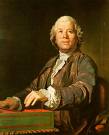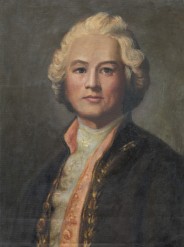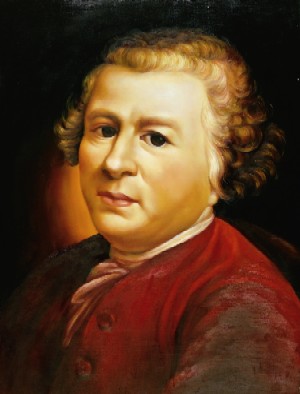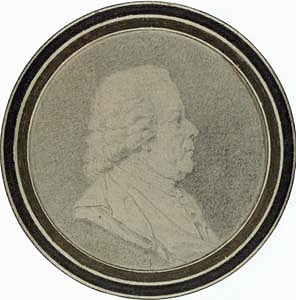

Gluck's father, Hans Adam, was hunting and
forest master for the Lobkowitz family in the Upper Palatinate,
later in northern Bohemia. The family relocated several times
during Christoph's young years, and little is known of the
boy's schooling or of his first music instructors. Gluck's
early attempts to practice musical instruments were reportedly
thwarted by his father, who had his son assist him in the hunt.
 By 1731 (though probably earlier) the boy had left home and
escaped to Prague, where he continued his musical studies and
supported himself partly as organist at the Tyn Church. He
matriculated at the University of Prague, but apparently
nothing came of his studies there. In music he remained
essentially self-taught. After a few years in Prague he went to
Vienna (probably 1735), where at the Lobkowitz Palace he met
the Milanese Antonio Maria Prince Melzi; in 1736 or early 1737
Gluck moved to Milan, having been hired as chamber musician for
Melzi's household. There he played violin in the prince's court
orchestra and probably also studied counterpoint and
composition with the city's leading musician, Giovanni Battista
Sammartini. Four years passed before Gluck's first opera,
Artaserse,
was produced at Milan in 1741; its success brought commissions,
and during the next four years Gluck composed seven more
operas, for Milan, Venice, Crema, and Turin. In 1745 he went to
London and composed two Italian operas for the King's Theatre
at the Haymarket. Thereafter he traveled to Dresden and Bohemia
and possibly also to Hamburg; by 1748 he was in Vienna, where
he had been commissioned to set Metastasio's
Semiramide riconosciuta
for the opening of the newly reconstructed Burgtheater.
By 1731 (though probably earlier) the boy had left home and
escaped to Prague, where he continued his musical studies and
supported himself partly as organist at the Tyn Church. He
matriculated at the University of Prague, but apparently
nothing came of his studies there. In music he remained
essentially self-taught. After a few years in Prague he went to
Vienna (probably 1735), where at the Lobkowitz Palace he met
the Milanese Antonio Maria Prince Melzi; in 1736 or early 1737
Gluck moved to Milan, having been hired as chamber musician for
Melzi's household. There he played violin in the prince's court
orchestra and probably also studied counterpoint and
composition with the city's leading musician, Giovanni Battista
Sammartini. Four years passed before Gluck's first opera,
Artaserse,
was produced at Milan in 1741; its success brought commissions,
and during the next four years Gluck composed seven more
operas, for Milan, Venice, Crema, and Turin. In 1745 he went to
London and composed two Italian operas for the King's Theatre
at the Haymarket. Thereafter he traveled to Dresden and Bohemia
and possibly also to Hamburg; by 1748 he was in Vienna, where
he had been commissioned to set Metastasio's
Semiramide riconosciuta
for the opening of the newly reconstructed Burgtheater.
 In 1750 Gluck married Maria Anna Bergin,
daughter of a merchant with close ties to the imperial court.
From 1752 until the 1770s he lived mostly in Vienna, where his
first employment was as
Konzertmeister
in the court of the imperial field marshal Prince Joseph
Friedrich Wilhelm of Saxe-Hildburghausen; there he came into
contact with
Kapellmeister
Giuseppe Bonno and with the young Carl Ditters (later von
Dittersdorf ). In 1754 Count Durazzo, imperial theater
director, began hiring Gluck to adapt French op&ras
comiques to the Viennese stage; from 1758 Gluck composed
several successful
opéras comiques
of his own for the Burgtheater, including
La fausse esclave
(1758). When Italian opera made a comeback on the Viennese
stage around 1760 (partly the result of the marriage of the
heir apparent, Joseph, to Isabella of Parma), Durazzo
introduced Gluck to librettist Raniero Calzabigi, and in 1761
the two collaborated on their first big success,
Don Juan.
Their even more important
Orfeo ed Euridice
was performed in 1762; it became a decisive work in operatic
quarrels of the period and remains one of the most rewarding of
all 18th-century operas. In 1767 the two collaborated again on
Alceste.
Gluck contributed a famous preface to the 1769 publication of
the opera; in it he expounded on his ideals of opera, stating
that in
Alceste
he had attempted to avoid the "disfiguring abuses" of Italian
opera and "to restrict music to its true office of serving
poetry by means of expression." He spoke against the florid
vocal display of the Italian style, ostensibly aligning himself
with "musical dramatists" through the ages.
In 1750 Gluck married Maria Anna Bergin,
daughter of a merchant with close ties to the imperial court.
From 1752 until the 1770s he lived mostly in Vienna, where his
first employment was as
Konzertmeister
in the court of the imperial field marshal Prince Joseph
Friedrich Wilhelm of Saxe-Hildburghausen; there he came into
contact with
Kapellmeister
Giuseppe Bonno and with the young Carl Ditters (later von
Dittersdorf ). In 1754 Count Durazzo, imperial theater
director, began hiring Gluck to adapt French op&ras
comiques to the Viennese stage; from 1758 Gluck composed
several successful
opéras comiques
of his own for the Burgtheater, including
La fausse esclave
(1758). When Italian opera made a comeback on the Viennese
stage around 1760 (partly the result of the marriage of the
heir apparent, Joseph, to Isabella of Parma), Durazzo
introduced Gluck to librettist Raniero Calzabigi, and in 1761
the two collaborated on their first big success,
Don Juan.
Their even more important
Orfeo ed Euridice
was performed in 1762; it became a decisive work in operatic
quarrels of the period and remains one of the most rewarding of
all 18th-century operas. In 1767 the two collaborated again on
Alceste.
Gluck contributed a famous preface to the 1769 publication of
the opera; in it he expounded on his ideals of opera, stating
that in
Alceste
he had attempted to avoid the "disfiguring abuses" of Italian
opera and "to restrict music to its true office of serving
poetry by means of expression." He spoke against the florid
vocal display of the Italian style, ostensibly aligning himself
with "musical dramatists" through the ages.
A number of Gluck's Italian operas from this period were revised for the Paris stage. During the 1770s the composer won further acclaim there with Iphigénie en Aulide (1774), Armide (1777), and Iphigénie en Tauride (1779). The 1770s also saw his health failing; he suffered an apparent stroke during preparations for his last opera, Echo et Narcisse. He returned to Vienna, and after a few years of marginal health (during which he prepared an important German version of Iphigénie en Tauride ), he finally succumbed to two more strokes. He was buried in Matzleinsdorf Cemetery (near Vienna); his body was later transferred to the city's main cemetery. Other theater works include Demofoonte (1743); Le nozze d'Ercole e d'Ebe (1747); Ezio (1750); Le cinesi (1754); L'innocenza giustificata (1755); Le diable à quatre (1759); L'ivrogne corrigé ( Der bekehrte Trunkenbold, 1760); Le cadi dupé (176 1); Il trionfo di Clelia (1763); La rencontre imprévue (1764); Telemaco (1765); Paride ed Elena (1770). He also composed sacred vocal works, including De profundis (performed at Gluck's funeral, 1787); secular vocal music, including songs and odes; and instrumental works, including at least eighteen symphonies and a set of six published trio sonatas (London, 1746). |

The last known portrait of Gluck, a silverpoint medallion drawing by Auguste St-Aubin. Courtesy Teri Noel Towe |
Supplemental Materials
Poetry and Prose
Articles